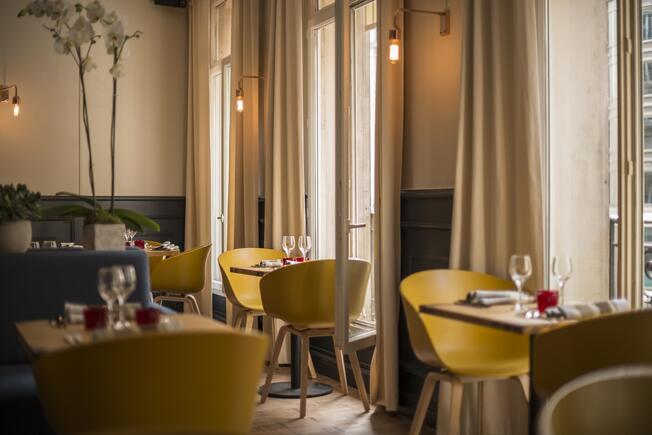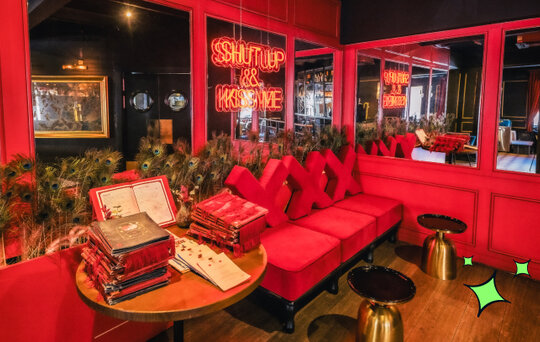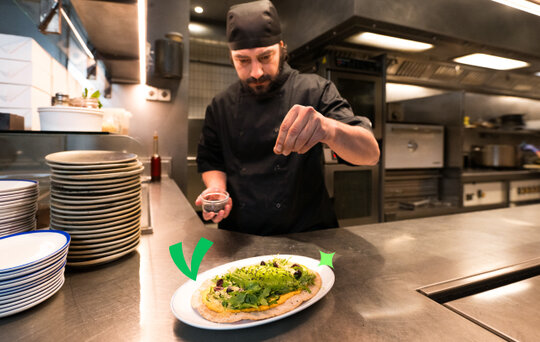How to design a restaurant floor plan

- • What is a restaurant floor plan?
- • What to include in a restaurant floor plan?
- • How to create a restaurant floor plan?
- • Try TheFork Manager today
- • Tips for designing a restaurant floor plan
- • Common mistakes to avoid when designing a restaurant floor plan
- • Restaurant floor plan software tools: what to use?
- • Empty tables and ever-increasing costs?
For most people, coming up with a great restaurant concept takes a lot of thought, a good grasp of the local competition and at least a few “Aha!” moments. Whether you're opening a brand-new restaurant or re-designing a business already in operation, a restaurant floor plan is an essential tool. By giving you an overall vision of your restaurant’s potential setup, a good plan will enable you to make the most out of your space, no matter how big or small.
Designing an accurate, comprehensive restaurant floor plan is one of the most important steps that should be done early on if you are opening a new restaurant or re-modelling an existing one. A floor plan is the blueprint that will empower you to turn your restaurant concept and brand into a reality. So, once you have defined the type of food, atmosphere, and service model you want for your dining establishment and found a location that fits your needs and budget, you’re ready to take on the next milestone: making a clear, comprehensive restaurant floor plan.
What is a restaurant floor plan?
A restaurant floor plan, which is usually digital but can also be hand-drafted, should map out your space’s layout to give you an overview of where everything in your restaurant will go.
Designed to scale, it should accurately show the relative positions of every room, electrical outlet, fixture, door, window, and entrance. In addition to indicating the size of each room and the distance between spaces, it should also show the individual layout for each section, including the positions of furniture, equipment and, most importantly, tables.
Every restaurant floor plan should take room capacity into consideration to outline the best layout and seating. Make sure to account for the following safety regulations:
- The ideal space per person is 18-20 square feet (1.67-1.86 square metres)
- Full-service should have a seat every 12-15 square feet (1.11-1.39 square metres)
- There should be at least 18 inches (45.72 cm) between each occupied seat.
- It is important to assess the shape of your dining tables to determine the number of seats that can fit around them. If you are using rectangular tables, you should leave 0.98 feet (30 cm) of space by the wall and at least 2.29 feet (70 cm) between the table and opening cabinets. A round table, on the other hand, highly depends on the number of seats you intend to position. Usually, 1.96 feet (60 cm) tables are suitable for two people, a diameter of 2.95 feet (90 cm) is perfect for three customers, and so forth.
- Do not underestimate the importance of how you arrange your kitchen. In your floor plan, opt for ergonomic furniture and equipment based on the height of your staff. Make sure each team member can easily reach every ingredient or device to ensure a smooth operation.
A properly executed, well-thought-out restaurant floor plan will help you make the most of your restaurant space, shape a better customer experience, and ensure the full safety of both clients and staff.
What to include in a restaurant floor plan?
A restaurant floor plan should include all areas of your establishment, including:
- Dining rooms
- Bars
- Entrances and waiting areas
- POS terminals and stations
- The kitchen, including food preparation, cooking and server areas
- Storage rooms and dishwashing areas
- Restrooms
- Corridors or stairwells
- Staff rooms
- Any outdoor spaces
Respecting the recommended distances between tables is essential. There should be at least 36 inches (91.44 cm) between the top edges of dining tables. It is crucial to consider these layout features to ensure compliance with restaurant safety regulations. This will ensure the comfort of customers and facilitate the movement of staff.
It is also crucial to include well-signposted emergency exits in the floor plan design. This will ensure the quick evacuation of staff and customers in case of an emergency.
According to legal accessibility regulations, all corridors and entrances must also be convenient for people with reduced mobility and have ramps where necessary.
How to create a restaurant floor plan?
When creating an effective and legally compliant restaurant floor plan, a series of elements must be considered.
- Once the precise dimensions of the premises have been defined, identify the main areas and ensure that the restaurant is highly visible from the outside.
- Windows allow natural light to illuminate the space. Also, consider the location of ventilation systems, particularly in the kitchen.
- Plan meticulously which functional areas to include. It is vital to understand where to position key zones, such as the dining room, waiting area, bar (near the entrance), and kitchen layout.
- Choose durable furniture that fits the restaurant’s style. The kitchen equipment must be efficient and comply with hygiene and safety regulations.
- Define the concept of your establishment: colours, materials, decorations, and all the elements that complement the desired atmosphere.
- Use specialised restaurant floor plan software, like SketchUp or SmartDraw. Remember to carry out design tests in the software to help visualise the layout.
For a professional result, consider enlisting the help of interior architects specialising in restaurants. Ensure you consult your team to better understand their professional requirements and conduct simulations in the actual space.
By following these steps, you will be able to create a restaurant floor plan that optimises workflow and ensures a pleasant experience for both customers and staff.
Try TheFork Manager today
Tips for designing a restaurant floor plan
When designing a restaurant floor plan, there are many factors to consider. Here are a few to get started:
- Restaurant building codes and regulations: An architect and interior designer should be able to advise on these, but it is always best to be as informed as possible when designing your restaurant floor plan. Consider social distancing guidelines in case of an epidemic, the number and position of fire exits, the designated areas for waste disposal, the required number and type of restrooms, etc.
- Accessibility guidelines and requirements: Ensuring that people with disabilities have access to the restaurant is not only morally right but also a legal requirement in many countries. Make sure that your architect is aware of your country’s accessibility requirements (height of tables, ramps, restroom access…) and incorporate these into the restaurant floor plan.
- Dining area size: According to restaurant industry experts, the dining area (including the bar, entrance and waiting areas) should typically take up 60% of your space, with the rest devoted to the kitchen.
- Meters squared (square footage) per customer: How many meters squared you allocate to each customer and table will depend largely on the style of restaurant service and atmosphere you are planning. Generally, fine dining or more high-end restaurants tend to allot more square meters per customer than casual or fast food restaurants. You also need to keep in mind the designated occupant load for each room in your restaurant. This refers to the maximum number of people that can be in a room at the same time while being able to escape in the event of a fire.
Restaurant table type and spacing: It is recommended that you offer a range of tables to accommodate different group sizes. Make sure to leave enough room between tables to allow people to circulate freely and safely. No one likes to feel crammed in.
Common mistakes to avoid when designing a restaurant floor plan
If you want to design a perfect restaurant layout, pay attention to some common mistakes that can compromise the functionality and safety of your establishment.
- Overloading the space with too many tables makes it difficult for wait staff to move around, obstructs access to emergency exits, and detracts from customer comfort.
- Neglecting the kitchen logistics and floor plan can hinder a fast and efficient workflow throughout the restaurant. For this reason, the preparation, cooking, and waiter collection areas need to be well-defined and organised to save time and focus efforts.
- Clearly signpost emergency exits to ensure that all areas of your restaurant comply with national and international safety regulations. This is also essential for people with reduced mobility.
A well-thought-out restaurant floor plan ensures the efficiency and success of your business!
Restaurant floor plan software tools: what to use?
Even if you plan to hire a professional interior designer or an architect to produce your final restaurant floor plan, you might want to brainstorm a preliminary design on your own.
Try using one of the many design software tools available today. Many of these tools allow you to integrate interior decorating features to give a more realistic picture of what your restaurant could look like. This is extremely useful for giving you an insight into your restaurant space, its advantages and its challenges. In this way, you will approach your floor plan with a clear mind when it comes to discussing the specifications with a professional.
Producing a realistic, detailed layout of your establishment will take a lot of planning. You will need to spend plenty of time studying your restaurant space (e.g. visibility from the street, natural sources of light at different times of day, existing plumbing fixtures, pros and cons of the space, etc.) and taking measurements.
This process will also force you to think carefully about the type of kitchen and dining room area you really want to create and how they will fit in with your restaurant’s personality and brand.
Try not to rush the planning stage. A well-designed restaurant floor plan can significantly enhance customers’ dining experience while streamlining day-to-day operations. Ultimately, a good plan will help you save money by avoiding potentially costly design mistakes.
Empty tables and ever-increasing costs?
- What is a restaurant floor plan?
- What to include in a restaurant floor plan?
- How to create a restaurant floor plan?
- Try TheFork Manager today
- Tips for designing a restaurant floor plan
- Common mistakes to avoid when designing a restaurant floor plan
- Restaurant floor plan software tools: what to use?
- Empty tables and ever-increasing costs?
















